Home | Front Page | Index | Blog | New | Contact | Site Map
Quiz Answer: La Quemada ruins, Zacatecas, Mexico

This site was occupied by early indians from about 400 A.D. until 900 A.D. and then abandoned, for unknown reasons. It seems to have been a ceremonial site, occupied by about 500-1000 people making up a royal and priest class. In the surrounding countryside there were many small villages with a large population.
Travel
Year In Review
(2002)
Book Reviews
Gerry's Grumbling
Jan's Jottings
Jokes
Jan's Resume
Friends' Pages
Recommended Links
Virginia
North Carolina
South Carolina
Georgia
Florida
Alabama
Louisiana
Texas
Arizona
California
Nevada
Egypt (Jan,2002)
Israel (Feb-Mar,2002)
Turkey (Apr-May 2002)
Bulgaria (early June, 2002)
Romania (early June, 2002)
Ukraine (June, 2002)
Poland (July, 2002)
Prague (July, 2002)
Britain (Aug-Sep) 2002
USA (Oct-Dec) 2002
Vietnam (Feb-May, 2001)
Laos (May, Jul, 2001)
Thailand (Jun-Sep, 2001)
Cambodia (Aug, 2001)
Britain (Sep-Dec, 2001
Paris 1999
China 1999
China 2000
Vietnam 2000
Britain 2000
Top
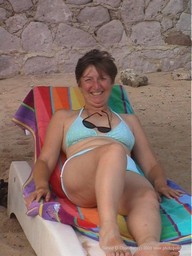
Jan on the beach at Mazatalan |
When we last left you, we had just crossed the Tropic of Cancer. That was exciting for us, thinking how far south we had gotten. At that moment we had no idea how far north we would be again. After a very laid back stay in Durango we slowly climbed to Mexico's continental divide and reached the Espinosa del Diabo, a windy road with high cliffs along it and at times steep drops. We were headed for beach land, the middle section of Mexico's Pacific Coast. There we stayed at the Mazatlan, Puerto Vallarta, and Melaque beach resorts and experienced two hurricanes. Then we headed back inland to see Guadaloupe and Zacatecas, the first a very fine colonial town and the second an excellent one. Finally, to our surprise, we ended up going back, via Saltillo and Monterrey, to the USA. And, the biggest surprise of all, in the USA we stayed four weeks.
Beach: September 19 - October 3
We worked our way south along 300 miles of coast, more or less, from Mazatlan to Puerto Vallarta (sort of midway) to San Patricio de Melaque (Melaque for short) where we fulfilled Jan's craving for warmth, an ocean breeze, and, yes, pools to swim in.
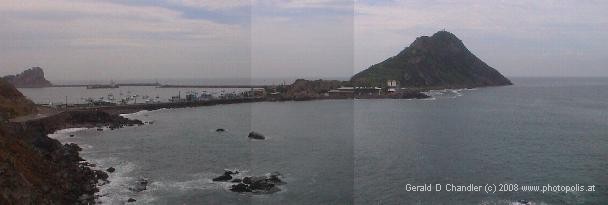
Rocky shore at Mazatalan |
Starting in Alabama where we met a Mexican waitress we had heard glowing reports of Mazatlan; the place half-filled them. It has a fine bay with beautiful views of the sunset, enhanced when we were there by the aftermath of a tropical storm. But the town as a whole is too large to be pleasant or interesting for the tourist and the old city, while not devoid of charm, doesn't rank with many other Mexican cities for interesting architecture and streets.
Puerto Vallarta, on the other hand, although a very big tourist destination, has retained much of its small town charm. The older part of the city is very pleasant to walk about in. We really did find the people here very friendly. This is one Mexican destination we would recommend for those of you who like beach vacations and want a fair amount of amenities.
But if you're like us and prefer the much smaller, less glitzy, quiet place then you would find our third stop, Melaque, more appealing. At 1/200 the size of Mazatlan and 1/20 the size of Puerto Vallarta, besides it hotels it only has a small center with a few restaurants. We had a beachfront hotel with a large veranda that gave us a terrific view of the bay; so terrific that it more than compensated for the waves thundering onto the sand, a thunder that kept us awake until our bodies and minds got accustomed to it.
Stretched out along maybe 10 miles north of the center of Mazatlan and 20 miles north and south of Puerto Vallarta are dozens of luxury hotels rubbing shoulders with large resorts and large time-share resorts. As they say, a funny thing happened on our way to visit them. We made some money. You can hardly be a tourist in these towns without being stopped by a tout for a visit to them. Show the slightest residence and they offer you a cash package. We did, they did, and we had enough to more than pay for our week's hotel.
We drove our Escort all along the route described and our happiness with our choice was reinforced when, leaving Puerto Vallarta, we met some people who took a cruise from Long Beach, CA. That morning we had seen from our balcony their ship coming into port. The Californian said that on ship the cruise was great, but they socked it too you when you came ashore. He and his companions were offered the choice of either a) walk a mile to a taxi, b) take a shore tour at $100 each, or c) rent a car for the day at $65. The four of them did the latter, and voila, our conversation.
Plateau: October 3 - 25
When we were thoroughly relaxed and beached out, we left the coast once more and headed back into the mountains to Mexico's second-largest city, Guadalajara. En route we stopped for two nights on the shores of Lake Chapala. (Lago de Chapala),Mexico's largest lake, 50% larger than Lake Tahoe and about the same size as Lake Geneva. Along its northern shore are several communities where about 6000 Americans live. Mostly retirees, they are numerous enough to have a monthly newsletter and to influence the kind of food stocked on supermarket shelves and the type and quality of food served in restaurants.
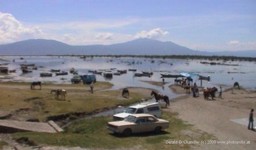
Shallows of Lake Chapala |
We stayed in Ajijic ("a-hee-heck"), which we think is the nicest. It's a small town between the main highway and the lake. Its streets are spotless, the people very friendly, and the atmosphere very relaxing. The others are Chapala, San Antonio, and San Juan Cosala. This was the first Mexican town since Creel that we half thought we could live in. The streets were spotless, the climate exquisite, and the food was the best we had experienced so far.
To digress here a little, we are not great foodies, but we have been very unimpressed by Mexican food. We positively avoid the omni-present frijoles (refried beans) and find most of the meat overcooked and overspiced for our taste with a definite lack of good, fresh, veggies. None of this was true in Ajijic. We ate our best meal in ages at a small restaurant on the main square of town. For 100 pesos (just under US$10) we got a three-course meal and a good glass of wine. The price itself was impressive, but was nothing compared to the quality of the food. We ate grilled salmon with an orange sauce that was delightful, sauteed vegetables that were perfectly crisp-tender, and followed up by the most scrumptious creme caramel we have ever tasted.
We had mixed expectations of Guadalajara: it comes highly recommended by guide books but we are not great lovers of big cities and there are four million people in the metro area, making it Mexico's second largest city. Driving in was like entering New York or San Francisco: you have to go through a lot of uninteresting suburbs to get to the heart, which did turn out to be a gem. We didn't know that at first as our first hotel was situated in an unattractive district. But once we moved to a quieter place with a Greenwich village atmosphere, we were seduced.
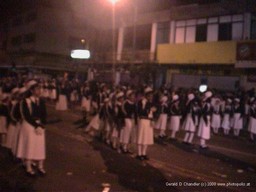
6:00 am Romeria parade start |
We were lucky enough to be in Guadalajar for the Romeria, the parade that accompanies the small statue of the Virgen de Zapopan from the cathedral of Guadalajara to her permanent home in el santuario de Nuestra Seņora de Zapopan (the sanctuary of Our Lady of Zapopan) in the nearby suburb (and once independent town) Zapopan. It was sort of like going from Wall Street to Flatbush Avenue. The ritual, which we sort of followed, is to stay up all night, attending mass, and at dawn set off for Zaponpan. As time went on we discovered and visited more museums and churches and the suburban towns of Tonala (The Bronx of the area) famous for its pottery, and Tlaquepaque (Tla-kay-pa-kay = Queens). Except for the horrendous noise of the city's traffic, we enjoyed the city very much.
On and off, ever since Gerry got his camcorder repaired in California, he has had some difficulty with it: mostly it would just suddently shut itself off. Sometimes to the accompaniment of a very dangerous sounding loud noise. Then in Puerto Vallarta the zoom feature gave out and the focus fixed itself on near-infinity. The evidence of this is on this page and in all of the photos for October: most of them are pretty low quality. There wasn't much we could do immediately, but wish. And then — another voila — one day on a walk in Guadalajara Gerry passed a Sony Repair shop. The short and bad news story is that after leaving it in the shop for 36 hours (no photos that day) is that repair would involve sending it to Mexico City for three or four weeks. Given the "manana" attitude of Mexico, it was "No, Senor".
On top of that we had an even more serious problem with our Fosa: it simply would not start. For months or even years, it had sometimes failed to start on the first push of the power button, but had always started on the second or third try. Now, for two weeks or so all efforts to coax life into it had failed. And then, as they sometimes say in physics, a miracle. We took it to a repair man in the middle of town, in a low cost computer mall, and he examined it a moment, decided the battery was bad, took it out, and — yes, voila — it worked.
The bottom line of these stories is that starting in Mazatlan we were looking for a replacement for the Fosa and now we wanted a replacement for the Sony camcorder. Funnily enough, it was Office Max that had the best selection available and Wal-Mart that had the second best. But prices were at least 50% higher than in the USA and the models available were limited and often out of date. We explored for a while finding a cheap flight to the USA (one person told us that we could find $100 flights in Guadalajara but that didn't pan out) but couldn't find any. So very gradually we gave more and more credence to the idea of going by land to the US border and shopping there. We'd decide a course of action in Zacatecas.
Our last major stop in northern Mexico was also one of our favorite places so far: the city of Zacatecas and its surroundings. In Zacatecas we found a city of ancient wealth built on silver mines that has developed into a cultural and historical center of great worth. The old historic center of town is very pretty and very well kept. It has a baroque church that outshines even the best of the many beautiful Mexican churches we had seen, and again we were lucky to be here during a street-theater festival and French cinema festival that satisfied some of our cultural cravings. We toured the mine that led to the city's founding, took the cable car to Cerro de la Buffa for a fine view of the city and visit to the museum that celebrates Pancho Villa's capture of the city in 1914. In the center along the main street are the exquisite baroque cathedral, several museums in converted convents and monasteries, and lots of romantic old Spanish architecture.
A very memorable part of our visit to Zacatecas was getting there. The road from Guadalajara does not climb over extremely high mountain passes. Rather, it winds along high mountain valleys, lush with grasses at the end of the rainy season and under the bluest of blue skies peppered with those delicious fluffy white clouds. Ever since our nine months under the polluted skies of China, we have had a deep, deep appreciaion for blue sky and clouds!

VW Beetle crashed on slope |
About 30 miles north of Guadalajara we came to a mirador and stopped for a look at the wonderful Rio Grande de Santiago valley. Coming down from the lookout we spied a red Volkswagen Beetle that had obviously gone off the road and landed 150 feet down a somewhat steep slope. Gerry went to investigate and soon saw that it could not be seen from the road. He climbed down and saw that the car had obviously flown through the air and had its flight ended by crashing into a tree. Inspection showed the windows all broken. Happily there was nobody or no body inside.
Our route to Zacatecas was only 200 miles, but our late start and unwilliness to drive at night meant that we stopped in Jerez. A fortunate necessity, as Jerez (named after the town in Spain for which Sherry is named) is a smaller version of Ajijic with the extra charm of a handful of very beautiful public buildings, funded by local wealthy silver-barons.
Big decisions are made in small steps. In Zacatecas we took the fatefull decision: we would go north and make a return to Saltillo, and see Doctor Ibara, who had told Gerry in April that he had facial basal cell carcinoma. It was only a four hour drive, and it would be nice to have her confirm what the Durango doctor said: it was cured. Then, since it would only be another five hours to Texas, we would go on and do our shopping. If we were lucky we could find something on the internet and get it shipped to us in a few days.
Plains: October 25 - November 20
Dr Ibara said all was fine and the next morning we left for Reynosa, on the Mexican side of the border, opposite McAllen. We spent the night there so that we could arrange auto insurance before entering the USA. That was accomplished by walking across the International Bridge (pedestrian toll 25 cents or 2 pesos; it is cheaper in Mexican money) and talking on the phone an hour with GEICO. But we did accomplish it.
The next morning it took an hour to cross the bridge and then we found ourselves in a strange land. We were used to arriving in a Mexican city knowing nothing of it. But here we were in McAllen, Texas without a map, without AAA Guide Books, without a book of discount hotels, and without our cell phone. The contract has expired the week before.
At least we spoke the language. Or so we thought. But, as it turned out, at least for asking directions Spanish was more useful than English. But we did find a hotel, find a restaurant, and so to speak, set up shop. It took us nearly two weeks, partially because we spent much more time investigating what was on the market than we had anticipated, but we did end up with two new high-tech gizmos. We found a great laptop for Jan (Acer TM290) at a Best Buy store in Brownsville, 60 miles away. And through the internet and help from our friend Moshe (who even hobbled out on his still healing foot) found a Sony Camcorder (DCR-PC330E) that had only been on the market since October.
New toys in hand, we should have left for Mexico. But we stayed on to finish two projects that have been hanging out there unfinished. The first, now done, was to collate a lot of material on the genealogy of Gerry's family and send it out to his relatives. The second, about to be done in a few paragraphs, is to write this report for our web and to generally update it, something that hasn't been done in months.
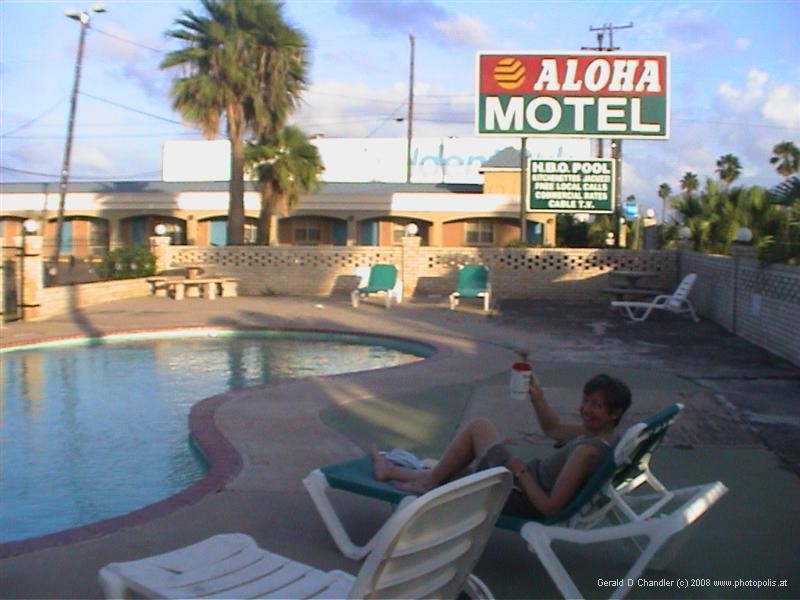
Jan at pool of Aloha Motel, McAllen, Texas |
This has been no hardship. We have been indulging ourselves by taking advantage of being in the U.S. to eat well (lots of buffet restaurants make that easy), to shop for smaller things like toiletries and stuff where we buy a particular brand that isn't available everywhere in Mexico, and to catch up on the news (CNN, CSPAN, Public Television, and best of all the New York Times!). Gerry has been back to his old bad habit of writing letters to the editor.
The motel also has a small pool which we try and stir up daily. We've gone from only managing 20 lengths (a VERY small pool) to 80 (maybe equal to 750 meters), so are feeling pretty good. It's important to try and work off the extra pounds put on by eating buffet meals!
How long do we expect to be here? As long as it takes, where "it" is the end of our list of things to do, including get this website uploaded. If you are reading it, we are probably already back across the border in Mexico. Hasta la vista, baby!